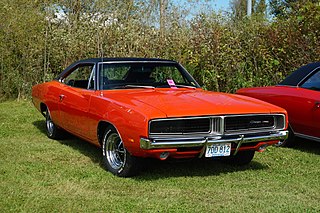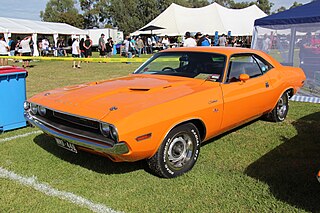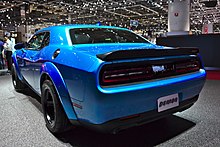Dodge is an American brand of automobiles and a division of Stellantis North America, based in Auburn Hills, Michigan. Dodge vehicles have historically included performance cars, and for much of its existence Dodge was Chrysler's mid-priced brand above Plymouth.

Muscle car is a description according to the online Merriam-Webster Dictionary in 2022 that came to use in 1966 for "a group of American-made two-door sports coupes with powerful engines designed for high-performance driving." The online Britannica Dictionary described these in 2022 as "an American-made two-door sports car with a powerful engine."

Plymouth was a brand of automobiles produced by Chrysler Corporation and its successor DaimlerChrysler. The brand was launched in 1928 to compete in what was then described as the "low-priced" market segment that was dominated by Chevrolet and Ford. It became a high-volume seller for the automaker until the late 1990s. Plymouth cars were marketed primarily in the United States. The brand was withdrawn from the marketplace in 2001. The Plymouth models that were produced up to then were either discontinued or rebranded as Chrysler or Dodge.

The Mitsubishi Galant is an automobile which was produced by Japanese manufacturer Mitsubishi from 1969 until 2012. The model name was derived from the French word galant, meaning "chivalrous". There have been nine distinct generations with total cumulative sales exceeding five million units. It began as a compact sedan, but over the course of its life evolved into a mid-size car. Initial production was based in Japan, but from 1994 the American market was served by vehicles assembled at the former Diamond-Star Motors (DSM) facility in Normal, Illinois.

The Dodge Charger is a model of automobile marketed by Dodge in various forms over eight generations since 1966.

Pony car is an American car classification for affordable, compact, highly styled coupés or convertibles with a "sporty" or performance-oriented image. Common characteristics include rear-wheel drive, a long hood, a short decklid, a wide range of options to individualize each car and use of mass-produced parts shared with other models. The popularity of pony cars is largely due to the launch of the Ford Mustang in 1964.

The Plymouth Barracuda is a two-door pony car that was manufactured by Chrysler Corporation from 1964 through 1974 model years.

The Mitsubishi Galant Λ (Lambda) is a two-door, four-seat hardtop/notchback coupé built by Mitsubishi from 1976 until 1984. From 1978, it was exported under various names; such as the Mitsubishi Sapporo in Europe and South America, the Dodge (Colt) Challenger and Plymouth Sapporo in North America and Puerto Rico, and the Chrysler Sigma Scorpion, Chrysler Scorpion and later the Mitsubishi Scorpion in Australia. It was also sold as a Sapporo in the United Kingdom under the Colt brand.

The Dodge Super Bee is a mid-sized muscle car marketed by Dodge, that was produced for the 1968 through 1971 model years.

The Chrysler Hemi engines, known by the trademark Hemi or HEMI, are a series of American V8 gasoline engines built by Chrysler with overhead valve hemispherical combustion chambers. Three different types of Hemi engines have been built by Chrysler for automobiles: the first from 1951 to 1958, the second from 1964 to 1971, and the third from 2003 to 2024. Although Chrysler is most identified with the use of "Hemi" as a marketing term, many other auto manufacturers have incorporated similar designs. The engine block and cylinder heads were cast and manufactured at Indianapolis Foundry.
Brampton Assembly Plant is a Stellantis Canada automobile factory located at 2000 Williams Parkway East Brampton, Ontario, Canada. Originally built by American Motors Corporation (AMC) for US$260 million, in the former Bramalea area of Brampton, the manufacturing plant was specially designed for building the Eagle Premier. Its role since has primarily been to assemble full-sized Chrysler products.

Windsor Assembly Plant (WAP) is a Stellantis Canada automobile factory in Windsor, Ontario. The factory opened in 1928 and Chrysler minivans production began in 1983. Windsor Assembly is Windsor's largest employer. The plant currently operates two shifts with over 4,200 employees.

The sixth and seventh-generation Dodge Charger are full-size four-door sedan, first introduced at the 2005 North American International Auto Show and built by American automobile manufacturer Stellantis North America, a subsidiary of Stellantis. It is available in rear-wheel drive or all-wheel drive drivetrains. The Charger was developed to continue the Dodge Charger line with its muscle car heritage, and replaced the Dodge Intrepid as Dodge's full-size sedan. The seventh generation Charger debuted for the 2011 model year.

The Dodge Charger (1966), also known as Dodge Charger (B-body), is a mid-size automobile that was produced by Dodge from 1966 through 1978 model years, and was based on the Chrysler B platform.

FCA Australia, known unofficially as Chrysler Australia or Stellantis Australia, is the official Stellantis subsidiary in that country, operating as distributor of Chrysler, Jeep, Dodge, Abarth, Alfa Romeo and Fiat vehicles. However, there had previously been a "Chrysler Australia Ltd" which had operated as a vehicle manufacturer in Australia from 1951 until 1980, and was subsequently taken over by Mitsubishi Motors Australia.

The Mitsubishi Lancer (A70) is the first generation version of Mitsubishi's long-running Lancer nameplate. When introduced in 1973, it filled the gap between the Minica kei car and the considerably larger Galant. It was a replacement for the Colt 1200, last sold in 1970. Although sedan production ended in 1979, vans continued on until 1985. This Lancer also formed the basis for the Lancer Celeste sports coupé of 1975 through to 1981. These Lancers were sold under a multitude of names in different markets.
Trans-Am production cars were factory-built pony cars based on vehicles raced in the Sports Car Club of America Trans-Am Series. These cars were used largely for homologation purposes, but also as promotional tools for the series. The first Trans-Am street car was Chevrolet's Z/28 Camaro, which entered production in 1967. By 1970 six makes were producing street cars based on their racing vehicles. Due to their low production numbers and high performance, these vehicles are highly collectible today.
Autodynamics Inc. is a former American racecar manufacturer based in Marblehead, Massachusetts. The company mainly produced Formula Vee and Formula Ford chassis. The company was also active in the Trans-Am Series entering Dodge Challengers in the 1970 season.

The Dodge Challenger is a full-size muscle car that was introduced in early 2008 originally as a rival to the evolved fifth generation Ford Mustang and the fifth generation Chevrolet Camaro.

The Dodge Challenger is a full-size automobile produced by American automobile manufacturer Dodge. The first use of the Challenger name by Dodge was in 1959 for marketing a "value version" of the full-sized Coronet Silver Challenger.
























